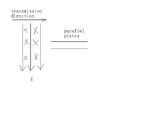xuexucheng
Full Member level 2
In free space, the TEM wave can transmit.
In a pair of parallel plates (transimision line), the mode is also TEM.
Why can not we use the parallel plates to receive the wave?
Why?
you may say the impedance is not match. but how can they be matched?
I find there is no any context about this in textbook.
Thank you very much.
In a pair of parallel plates (transimision line), the mode is also TEM.
Why can not we use the parallel plates to receive the wave?
Why?
you may say the impedance is not match. but how can they be matched?
I find there is no any context about this in textbook.
Thank you very much.
